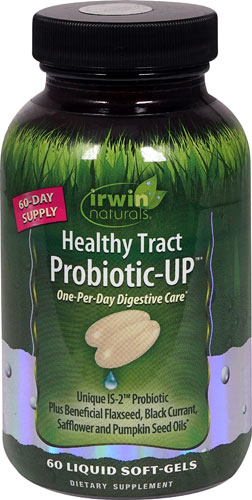Probiotics are well-known for their potentially positive effects on the gut, but postbiotics are relatively new on the scene. Also called
metabiotics, biogenics or metabolites, these byproducts of digestion started gaining some recognition in scientific literature beginning in 2014.

But postbiotics have been around for a lot longer than that; they’re as old as long as the human gut microbiome itself! These compounds, including short-chain fatty acids (SCFAs), lipopolysaccharides,
muramyl dipeptide, conjugated linoleic acid and
sphingolipids, are naturally produced during digestion and can have significant benefits for health.
What are postbiotics?
Probiotics are live microorganisms—like bacteria and yeast—that provide benefits as a result of how they function in the gut.
Postbiotics are the byproducts of these functions and can include cells, cell walls and byproducts of cell breakdown, as well as microbial secretions and metabolites.
Unlike probiotics, postbiotics aren’t alive. The cells and cell fragments can’t divide or produce new cells, and secretions and metabolites are both created as a natural part of the microbial life cycle. Because these compounds are left behind by probiotic cells, they can be found in foods created using traditional fermentation processes, such as yogurt, sauerkraut, kombucha and sourdough bread.
How postbiotics are made
So, where do postbiotics come from? It’s an interesting progression:
- Prebiotic fiber is consumed in the form of fruits, vegetables, whole grains beans and other plant foods.
- The soluble forms of these fibers “feed” probiotic gut microbes
- Gut microbes produce their postbiotic byproducts
The process is similar in fermented foods, except the microbes feed on sugars in the food and convert them into other compounds, including postbiotics.
Postbiotic benefits
Each type of postbiotic has functions in the body, and research is being done to discover just how they work. Although no one is yet sure of the exact mechanisms of action, several postbiotic benefits have been observed, including
†:
So far, SCFAs are the most well-known for their positive effects. One particular SCFA called butyrate is somewhat of a superhero among these compounds. Butyrate improves colon cell health and builds up the lining of the gut, which can help strengthen the gut barrier and reduce problems associated with
leaky gut.
Turn your gut into a postbiotic machine
An optimal prebiotic-probiotic-postbiotic cycle in the human body requires healthy levels of fiber intake from whole foods, as well as a balanced gut microbiome.
What’s the best way to achieve both? Start with your diet—specifically, increasing fiber. Most people in developed countries don’t eat enough high-fiber foods, so they’re missing out on the power of postbiotics (not to mention all the other benefits of fiber).
Whole plant foods are the best sources of fibers like fibers like
fructans, oligosaccharides, resistant starches and polyphenols, which are just a few of many
prebiotics that fuel postbiotic production. If you haven’t been eating very many of these, increase your intake slowly to minimize digestive symptoms like bloating and gas.
You can also start incorporating more fermented foods into your diet. Try putting sauerkraut on salads or making sandwiches on whole-grain sourdough bread. For a super dose of postbiotic power, spoon some almond, cashew or coconut yogurt onto your morning oatmeal along with fruit!
What about postbiotics supplements?
Supplementing with postbiotics hasn’t hit the mainstream yet, but the idea is becoming more popular since the compounds are more stable than probiotics and don’t carry the same risk of potential infection in people with weakened immune systems. This stability may also allow postbiotic supplements to retain their benefits for longer than live probiotics and avoid destruction during digestion so that the entire gut can get a health boost.
If you want to try postbiotics in pill form, you can supplement with SCFAs like butyrate. Another supplement called “dried yeast fermentate,” sold under the registered trademark EpiCor, is made using a proprietary process to produce postbiotic metabolites by fermenting baker’s yeast.
Some probiotic supplements also contain postbiotics, which serve the dual function of
strengthening the gut and balancing the microbiome.
Good diet, happy Gut
Although some supplemental postbiotics have been shown to provide health benefits, the best way to boost postbiotics in your gut in the long term is to provide your microbiome with the raw materials to make them.
What you feed your gut microbes influences the types of postbiotics they produce. The more high-fiber whole plant foods you eat, the more prebiotic fuel your microbiome will have—and the healthier your gut will be. Start adding these foods to your diet today to see how much better you feel.
†These statements have not been approved by the Food and Drug Administration. These products are not intended to diagnose, treat, cure or prevent disease.
Featured products



 But postbiotics have been around for a lot longer than that; they’re as old as long as the human gut microbiome itself! These compounds, including short-chain fatty acids (SCFAs), lipopolysaccharides, muramyl dipeptide, conjugated linoleic acid and sphingolipids, are naturally produced during digestion and can have significant benefits for health.
But postbiotics have been around for a lot longer than that; they’re as old as long as the human gut microbiome itself! These compounds, including short-chain fatty acids (SCFAs), lipopolysaccharides, muramyl dipeptide, conjugated linoleic acid and sphingolipids, are naturally produced during digestion and can have significant benefits for health.






